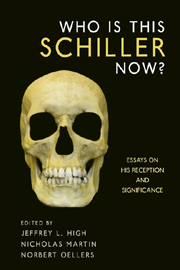Book contents
- Frontmatter
- Contents
- Foreword
- Acknowledgments
- List of Abbreviations
- Introduction: Why Is This Schiller [Still] in the United States?
- Part I Schiller, Drama, and Poetry
- Part II Schiller, Aesthetics, and Philosophy
- Part III Schiller, History, and Politics
- 12 Schiller und die Demokratie
- 13 God's Warriors, Mercenaries, or Freedom Fighters? Politics, Warfare, and Religion in Schiller's Geschichte des Dreyßigjährigen Kriegs
- 14 Who Is This Black Knight? Schiller's Maid of Orleans and (Mythological) History
- 15 Religion and Violence in Schiller's Late Tragedies
- 16 So Who Was Naive? Schiller as Enlightenment Historian and His Successors
- Part IV Schiller Reception — Reception and Schiller
- Part V Schiller Now
- Notes on the Contributors
- Index
14 - Who Is This Black Knight? Schiller's Maid of Orleans and (Mythological) History
from Part III - Schiller, History, and Politics
Published online by Cambridge University Press: 05 February 2013
- Frontmatter
- Contents
- Foreword
- Acknowledgments
- List of Abbreviations
- Introduction: Why Is This Schiller [Still] in the United States?
- Part I Schiller, Drama, and Poetry
- Part II Schiller, Aesthetics, and Philosophy
- Part III Schiller, History, and Politics
- 12 Schiller und die Demokratie
- 13 God's Warriors, Mercenaries, or Freedom Fighters? Politics, Warfare, and Religion in Schiller's Geschichte des Dreyßigjährigen Kriegs
- 14 Who Is This Black Knight? Schiller's Maid of Orleans and (Mythological) History
- 15 Religion and Violence in Schiller's Late Tragedies
- 16 So Who Was Naive? Schiller as Enlightenment Historian and His Successors
- Part IV Schiller Reception — Reception and Schiller
- Part V Schiller Now
- Notes on the Contributors
- Index
Summary
The Schiller Nationalausgabe lists Hume and Thoyras as being among Schiller's sources for both Maria Stuart (Mary Stuart, 1800) and Die Jungfrau von Orleans (The Maid of Orleans, 1801). Both texts contain detailed descriptions of the battles of Crécy and Poitiers: Shakespeare's Henry V had introduced Schiller to the extraordinary exploits of Edward the Black Prince of Wales, the scourge of France during the Hundred Years' War. Schiller required a nemesis for Joan of Arc, and remaining true to form, pulled the character from history. The appearance of Edward's ghost serves as a plot device: Schiller transforms a legendary, yet human, Black Prince, into an emissary of history compelling enough to return Joan to her historical responsibility. In response to his challenge, Joan transcends her role as a tool of the divine to become an Enlightenment liberation heroine.
IN DIE JUNGFRAU VON ORLEANS: EINE ROMANTISCHE TRAGÖDIE (The Maid of Orleans: A Romantic Tragedy, 1801), Schiller transforms the ostensible “history” of the martyred teenager's mythological mission into a work that embraces the philosophy of the Enlightenment. Specifically, Schiller's version replaces the divine mission of Joan of Arc with the philosophical ideas of human secularism and both individual and political autonomy. As late-eighteenth-century German literature and art moved from the Enlightenment's more rigid pursuit of verisimilitude toward the ambiguous symbolism of Romanticism, Die Jungfrau von Orleans, written before Early Romantic theory had resulted in any significant Early Romantic works, demonstrates characteristics of both movements.
- Type
- Chapter
- Information
- Who Is This Schiller Now?Essays on his Reception and Significance, pp. 236 - 246Publisher: Boydell & BrewerPrint publication year: 2011



